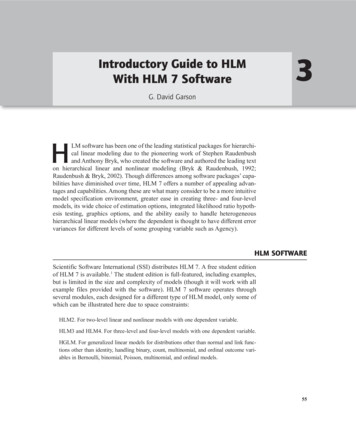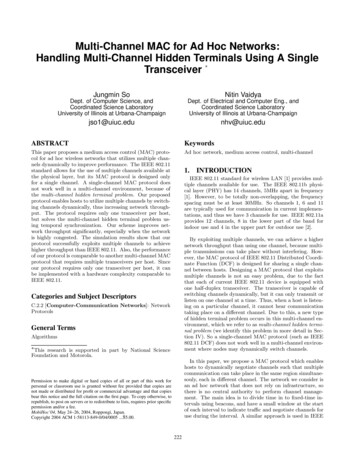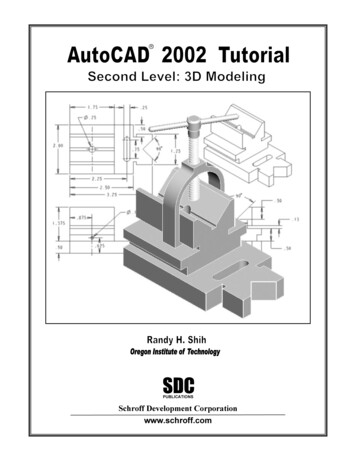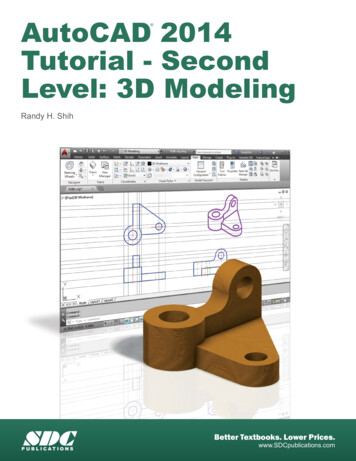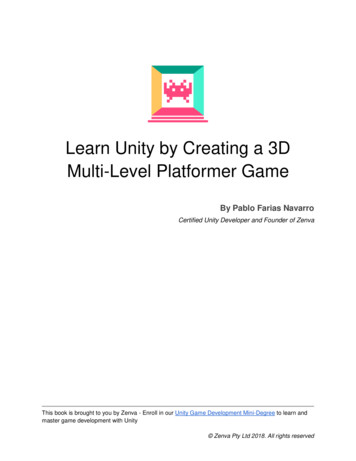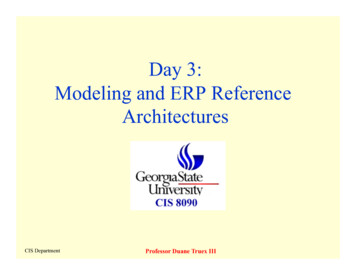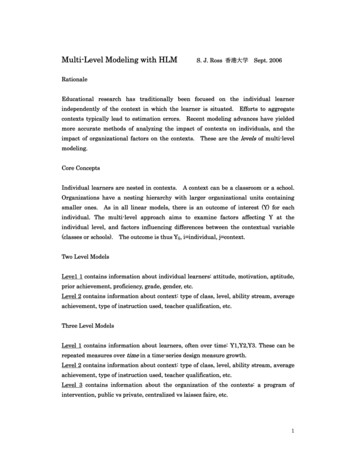
Transcription
Multi-Level Modeling with HLMS. J. Ross 香港大学Sept. 2006RationaleEducational research has traditionally been focused on the individual learnerindependently of the context in which the learner is situated.contexts typically lead to estimation errors.Efforts to aggregateRecent modeling advances have yieldedmore accurate methods of analyzing the impact of contexts on individuals, and theimpact of organizational factors on the contexts.These are the levels of multi-levelmodeling.Core ConceptsIndividual learners are nested in contexts.A context can be a classroom or a school.Organizations have a nesting hierarchy with larger organizational units containingsmaller ones.As in all linear models, there is an outcome of interest (Y) for eachindividual. The multi-level approach aims to examine factors affecting Y at theindividual level, and factors influencing differences between the contextual variable(classes or schools).The outcome is thus Yij, i individual, j context.Two Level ModelsLeve1 1 contains information about individual learners: attitude, motivation, aptitude,prior achievement, proficiency, grade, gender, etc.Level 2 contains information about context: type of class, level, ability stream, averageachievement, type of instruction used, teacher qualification, etc.Three Level ModelsLevel 1 contains information about learners, often over time: Y1,Y2,Y3. These can berepeated measures over time in a time-series design measure growth.Level 2 contains information about context: type of class, level, ability stream, averageachievement, type of instruction used, teacher qualification, etc.Level 3 contains information about the organization of the contexts: a program ofintervention, public vs private, centralized vs laissez faire, etc.1
Two Level ModelsStep 1 Check Level 1 file structure. The key field should be left-most and indicate thenesting structure at level 1. Here, ‘sect’ (classes) are the larger nested unit.z In the Level 1 file, variables of interest at the individual student level are held.The left-most variable ‘sect’ indicates that the first 15 students are nested in Class1.z Three individual difference variables are listed for each student: gender, previousachievement (GPA) and initial proficiency (TOEFL).These may serve as covariatesor as moderators for the outcomes of interest.z The right-most variables Fscor1 and Fscor2 are ‘factor scores’ for each individualstudent indicating his or her own tendency to agree with a 10 item survey about theusefulness and validity of PEER ASSESSMENT.These serve as the twodependent variables in the multi-level analysis.2
Step 2: Check Level 2 file structure.The left-most field should be the key variable fornesting at both Level 1 and Level 2.Here ‘Sect’ indicates classes.class averages for the PEER ASSESSMENT attitude survey.Fac1 and Fac2 areCOHORT refers to thoseclasses experiencing a PA training module vs classes that did not experience one.z Level 2 variables describe features of the sections (classes), not the individualsnested within the classes.These can be dummy codes (e.g. cohort identifier), or canbe averages for the class variables (e.g. SES, Proficiency, Motivation, etc).Theyshould define the ‘context’ in which individuals are nested.Step 3 Conversion to HLM files. Define the source file (SPSS, SYSTAT, etc)3
Step 4 Locate data setsStep 5.Browse Level 1 file first and identify the key field.Specify variables foranalysis.4
Step 6.Repeat process for Level 2 fileStep 7 Select key field and Level 2 variables5
Step 8 Save Response file and check to make sure that the HLM files have been createdImportant Points:HLM requires two different data sets.Level 1 contains the outcomes data andindividual level predictors/covariates of the outcome arranged in a row by column dataset.Input can be via SPSS, SYSTAT, STATA, or ascii files. The second required file isfor Level 2 data and contains covariates describing the context or institutionalorganizational structure: the school, class, teacher, or features of the nested Level 1data such as SES, etc.6
HLM Analysis.Example 1.Learner attitudes toward peer assessment are the objectof interest. A survey is given to 569 undergraduates who recently experienced peerassessment. Students are nested in 39 classes.sections.Teachers are assigned multiple classCan learner attitudes towards peer assessment be influenced by ‘innovationtraining’?In a contiguous cohort design, one cohort of learners does formativeassessment over an academic year.The following year, another cohort does formativeassessment, but receives modules designed to instruct the learners on how to do fairand accurate peer assessment.Does innovation training help?Survey Factorial StructureFactor Loadings RE0.0-0.5-1.0-1.0-0.50.00.5FACTOR(1)1.0Factor 1 members: More PA is needed, PA is motivating, PA gives deep assessments, PAgives learners better understanding. Factor 2 members: PA are honest, PA instructionsare clear, PA is easy to do, PA is simple to implement. High scores imply agreement.7
Peer Assessment TrainingDo learners need peer-assessment training? Two cohorts of learners are compared.Cohort 1 experienced peer assessment prior to competing the attitudes about peerassessment survey. Cohort 2 got a regime of propaganda and instructions on how to doaccurate and fair peer assessment. RQ:Is there a difference between the cohorts ontheir attitudes towards peer assessment?HLM2 Set upLet us assume that we are interested in between-class differences in Factor 2. Westart with an unconditional model: there are no covariates at all.This is equivalent toa random effects analysis of variance (ANOVA).The above model yields:8
We can see as expected that the average standardized agreement across the 39 classesis 49.8 on the FS2 scale. We see also that there is considerable variation among theclasses in agreement: not all of them see peer assessment as useful.10.9/(89.4 10.9) or about 11% of the variance is between the classes.We note also thatWhy do classesdiffer?Level 1 (student) factors.We can now modify the unconditional model by adding Level 1 variables.We will testthe hypothesis that relative prior student achievement and relative proficiencydifferences affect class mean differences in valuing peer assessment. In other words,do the normative environments within classes affect student valuing of peerassessment?9
10
The top panel indicates classes differ, and that relative mean achievement (GPA) has asignificant effect on positive attitudes towards peer assessment (t 3.326, p .002).Differences between classes in relative proficiency (TOEFL) don’t inform us on thisissue.We are now ready to model the impact of training learners to do peer assessment. Wewill add the training variable at Level 2 (COHORT) and model its impact on thedifferences between the 39 classes.This is known as an intercept-as-outcomesanalysis since it examines the between-class differences controlling for the classcompositional effect of prior achievement (GPA).The COHORT (PA training) does have an impact; the difference between the trainedand non-trained classes leads to a difference in 5.03 scaled FS2 points of attitudetowards peer assessment.11
We now turn to a related question.How does PA training moderate (interact with) theaverage achievement effect (GPA)? Does training have a differential affect for relativehigh and low achievers? Each class’s relative mean achievement (centered GPA) is theLevel 1 covariate. The object of interest is whether the training in peer assessmentmoderates the effect of prior achievement (GPA) in each student’s attitude toward peerassessment.Here we focus on the slopes as outcome model.12
There is a just-significant effect for the training (COHORT) interacting with thebetween-class GPA covariate at Level 1. This implies there is a positive effect fortraining on mean GPA. We can visualize this impact by plotting the centered GPA byCohort by FS2 scores:59.11COHORT 1COHORT 6GPAThe slopes of the trained cohort (2) classes are steeper than those of the untrained13
cohort classes.We note also that the relatively lower achieving class sections have thesteepest slopes.We might infer that the training regime affects some of the attitudesof the lower achieving classes more than it does for the higher achieving classes.HLM3Valued-Added Assessment Research.In educational policy analysis, acommon goal is to assess the impact of interventions.VAA is a growth-referencedapproach aiming to assess the longitudinal growth of learners nested in contexts. In thisexample there are three levels: 1 the growth data (repeated measures); 2 learnervariables; 3 contextual (class, school, or policy) characteristics. 2121 students are in 69classes.HLM3Note the structure of the growth data: repeated measures are stacked and noted for theserial order of their measurement (time) creating a vertical time-series data set.14
And locate the level 1 data set designed here as an SPSS file15
Select nesting variables (classes or sections) and the growth data at level 1.Next, the learner level data set is located and browsed.16
Note the left-most (common linking field) is the class section.the student ID.The Level 2 key field isThe student characteristics, sex, hours of self study, hours of extracurricular contact with native speaker, hours of use of English media, and otherexposure are possible covariates.Finally, the Level 3 data set containing the context (class, teacher, syllabusfocus, etc) is specified:17
Note again that SECT is common to all three levels. R (reading teachers’) testpreparation (a self-reported dichotomy), homogeneity of materials, possession of agraduate degree, and years of experience.A parallel set of teacher characteristics arefor the C (conversation) teachers.Modeling Value-Added OutcomesThe first goal is to assess the evidence that there has been growth over the year of theprogram. We focus first only on Level (time) and assess the difference in LISTENINGproficiency (measured by TOEIC Bridge) before and after the program.We focus first at the differences between the 69 class sections. Note the yellow focus barcan be moved and clicked to darken the residual ro, to model a random coefficient(assumed to be generalisable). When effects are not random, they are consideredsample-specific, or fixed effects.18
The t-ratio of 38.136 shows considerable variation in listening growth between the 69classes, and between the 2121 students (measured twice) within them. RQ: Whatlearner characteristics at level 2 co-vary with differences in growth between classes?Hypothesis: extra curricular contact with native speakers NS (self-reported hours perweek) co-varies with growth and affects between-class differences (pi0) and individualstudent gains over time (pi1).19
The null hypothesis cannot be rejected for either effect.Self-reported contact does notaffect between class differences or even growth in listening.RQ1. Do male and female students make comparable gains across classes in thisprogram? Here a dummy code for sex replaces NS as the focus of the level 2 analysis.20
The t-ratio of 2.78 indicates p .006 that there is a gender difference influencing thedifference between the class sections.Level 3 Analysis: What is the moderating influence of teachers’ decision to focus ontest-prep on the gains in listening between class sections?21
We can infer that the test-preparation does not have an impact on the gains at all.RQ3:Does teacher qualification provide a value-added influence?CGrad is a dummycode for self-reported possession of an M.A/M.Ed degree or higher by each instructor. Wewill also include another concurrent covariate: teachers’ years of experience.22
Results: Evidently there is a value-added impact for graduate education, but not foryears of experience.Good news for the Graduate School of Education!Multi-Level models are useful for understanding the covariates of growth and can beused to assess educational policies and interventions. They work best with at least 30level 2 units (classes, teachers or schools)Heck, R. and Thomas, S. (2000) An Introduction to Multilevel Modeling Techniques. Mahwah, NJ:Lawrence Erlbaum Associates.Raudenbush, S. and Bryk, T. (2002) Hierarchical Linear Modeling 2nd Ed. Thousand Oaks, CA: Sage.Wainer, H. (2004) Introduction to value-added assessment special issue. Journal of Educational andBehavioral Statistics 29, 1, .pp 1-4.Doran, H. and Lockwood, J. (2006) Fitting value-added models in R. Journal of Educational andBehavioral Statistics 31,2, pp 205-230.23
24
Step 8 Save Response file and check to make sure that the HLM files have been created Important Points: HLM requires two different data sets. Level 1 contains the outcomes data and individual level predictors/covariates of the outcome arranged in a row by column data set. Input can be
